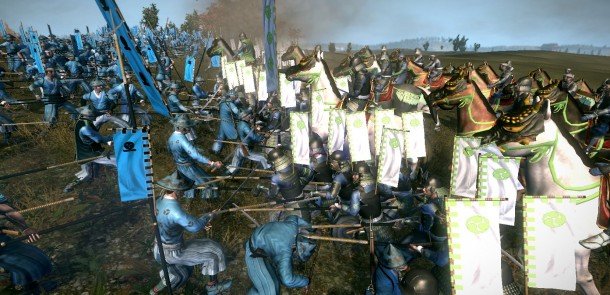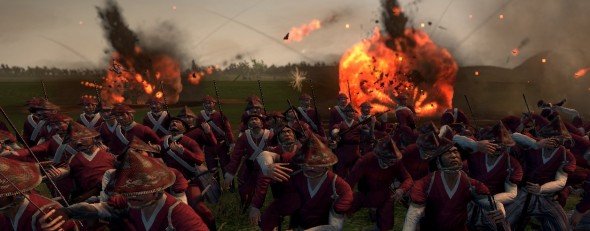Shogun 2: Fall of the Samurai: ten tips to help you take Japan

Standalone Total War expansion, Fall of the Samurai, is out, and it's really rather good. You can find out exactly why in our Shogun 2: Fall of the Samurai review. You'll be fighting for tradition and the Samurai way on the Shogun's side, or battling to restore the Emperor to supremacy, but carving out your empire in the midst of a civil war isn't an easy task. The standalone expansion adds 39 new units, three new agents and a bunch of new boats. There's a new tech tree, railways and dramatic new weapons like naval artillery and gatling guns to get to grips with.
There's so much to do. Where should a new general start? Who should you kill first? Which are better, swords or guns? Is Sun Tzu's Art of War actually useful? (yes, if you're monitor's a bit low down, plonk it on top of the ancient tome, voila). Here are ten top tips to help you take back Japan.
Set up trade routes quickly

Building an empire is expensive. Never mind the cost of training troops and building boats, it's the upkeep that you need to worry about. Soldiers are always hungry and boats have a habit of breaking. That'll cost you a set amount of gold every turn. In Total War, quick money is hard to come by. You can take an enemy town and sack it for all it's worth, or just set up a trade route.
Doing a deal with another clan will instantly secure you a boost to your income every turn, but the number of trade agreements you can set up is limited by the number of ports you control. Your first step should be to send out a small fleet to skirt the shores of Japan. Whenever you catch a glimpse of an undiscovered faction, you'll be able to set up a meeting straight away and start negotiations.
In Fall of the Samurai, your relationships with other clans will be affected by your allegiance with the progressive Emperor or the traditionalist Shogun. If a clan's on the other side, they won't like you very much. That's why it's best to discover as many factions as possible as quickly as possible. The deals you do should be limited by the number of ports you have, not the number of factions you can talk to.
It's worth keeping an eye on which resources are in demand. If you see one selling for a good price, upgrade the mines and mills that generate that resource to boost that vital trade income.
Use artillery always

Ships can now bombard cities, mines, farms, railway stations and even armies from the safety of the sea. If one of your armies enter battle within a friendly fleet's circle of influence on the campaign map, you'll be able to call down artillery to smash your enemies on the battlefield. This is an extremely powerful ability that you'll want to use constantly throughout your Fall of the Samurai campaign.
Keep up to date with the most important stories and the best deals, as picked by the PC Gamer team.
On the strategic campaign map, you should use fleets to strike at unguarded resource buildings scattered throughout enemy provinces. You can hammer farms and mines into disrepair, damaging your opponent's economy. They'll have to spend some gold to get those buildings repaired as well, making shoreline bombardments a great way to soften up a province for invasion.
Naval artillery can be even more useful in battle. As long as the fight is initiated within the circular range indicator of your fleet on the campaign map, you'll be able to call down a couple of devastating bombardments during the real time battle. You can choose a focused bombardment, which is useful if you're going for a high-risk strike on a vital enemy unit (the one that carries their general, for example), but you'll probably do better with the less accurate strike. This will spread out the incoming shells, delivering less destruction over a wider area, but more disruption to the enemy line.
A well timed strike can obliterate enemy armies in tight rank and file formation. If you're lucky, your strike will result in plenty of casualties, but even if you don't score a direct hit, the force of the impacts will send soldiers flying. This can scatter your foe's formation and open up gaps in their gunlines. Once you've called in the big guns, there's a bit of a wait before it arrives. Getting barrages on target can take a bit of practice. If you master artillery, you've added a devastating weapon to your arsenal.
Build boats. Lots of boats

Naval artillery is an important weapon, but your fleets have an even more vital task. You must protect your trade ports at all costs. At high tech levels, you can upgrade those ports to international trade centres. These bring in immense riches and give you the opportunity to recruit troops from overseas. If your enemy blockades a port, it'll cost you thousands in gold and you'll lose those recruitment options.
Don't let that happen. A fleet can travel a long way in a turn, which means they can protect wide stretches of coastline from would-be pirates. It's worth keeping a few souped up fleets as high-impact defensive armadas designed to crush raiding parties. Likewise, send out small squadrons yourself to harass enemy resource points and raid trade routes. Maintaining all these ships will be expensive, but it's worth it.
Once you've researched the tech, it's worth upgrading your port defences. This will install a series of huge cannon emplacements around your shipping centres that will automatically lay damage on any enemy fleets within range. You'll even be able to see these tiny cannon emplacements firing away on the strategic campaign map.
Part of the UK team, Tom was with PC Gamer at the very beginning of the website's launch—first as a news writer, and then as online editor until his departure in 2020. His specialties are strategy games, action RPGs, hack ‘n slash games, digital card games… basically anything that he can fit on a hard drive. His final boss form is Deckard Cain.


